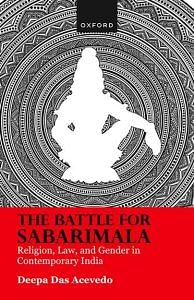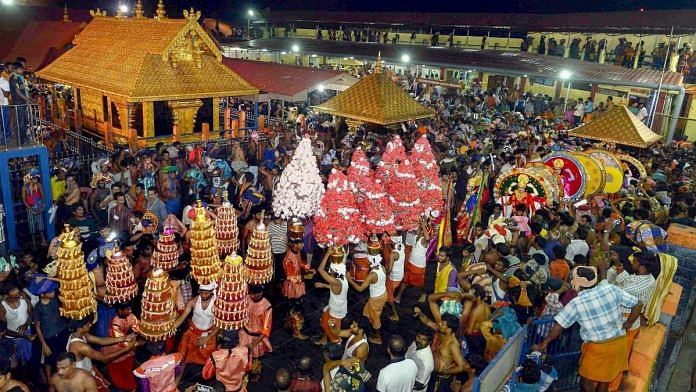To everyone’s surprise, the actress Jayamala confessed that she had done it. It was the summer of 2006, and all was not well at the Sabarimala temple. A hired astrologer had just announced that the deity was displeased: rituals were being inadequately observed, development projects were causing no end of trouble, and contrary to the temple’s long-standing rules, a woman had entered its premises. Things would have to change. For a split second after Jayamala’s confession came in, via fax to the temple administrator’s office, it seemed as if matters were coming to a head. Within days, however, it had all fallen apart.
Jayamala’s confession was universally disbelieved. How could any beautiful, young actress—no megastar, she, but in 1987 still a charming twenty-seven-year-old—have gone unnoticed in a crowd of male worshippers? How could any woman have accidentally tripped across 15 feet of well-guarded space and up the final steps into the inner sanctum? Sabarimala’s chief priest was confident in his dismissal of the story, but he oversaw a purification ritual nonetheless.
Soon, hints of a darker offence began to emerge, of conspiracy and deception and a determination to achieve fame by any means. The astrologer and the actress were in cahoots, the media concluded, and turned to other matters. The courts, on the other hand, were just getting started. Over the next six years, the Jayamala scandal would ricochet among multiple tribunals, the government of the State of Kerala, the Crime Branch of the Kerala Police, and various members of Sabarimala’s religious and administrative hierarchies.
Every so often, a new official would rediscover the episode, and the media, which never tired of stories involving one of Kerala’s most powerful temples, would obligingly follow suit. Jayamala herself was eventually charged with the crime of ‘hurting religious sentiments’ under India’s labyrinthine nineteenth-century penal code. The charges were carefully constructed: although it was by now assumed that she could not have actually visited Sabarimala, and although her visit—had it happened—would not have broken any laws, Jayamala’s claim to have violated the temple’s proscription against fertile women was itself said to offend believing Hindus. At long last, in 2012, a judge of the Kerala High Court dismissed all the charges against her. The Jayamala scandal was not the first time Sabarimala’s ‘ban on women’ had inspired legal action, and it would not be the last or even the most important.
In fact, throughout the six-year saga that followed her faxed confession, the ban itself played second fiddle to the woman who had supposedly violated it. In 2006, nobody argued that Sabarimala should not be allowed to exclude women from its premises, and nobody questioned the temple’s rationale for doing so. But the Jayamala scandal opened the door for a broader debate over Sabarimala’s admission practices, and for one of the most hotly litigated cases in contemporary India. The lawsuit that eventually emerged from Jayamala’s confession, Indian Young Lawyers Association v. State of Kerala, inspired protests across India and influenced the national elections of 2019.
It was filed in 2006 by a group of lawyers in New Delhi, some 2,600 kilometres and a universe away from Sabarimala, who had read about the purification rituals conducted in the aftermath of Jayamala’s improbable visit. It did not matter, the lawyers argued, that only women between the ages of ten and fifty were forbidden from entering the temple. It also did not matter that some temple authorities believed the ban to be religiously necessary. No temple in modern India ought to exclude devotees on the basis of their sex, said the lawyers—certainly no temple associated with Hinduism, which they argued was a uniquely inclusive religion, and most definitely no temple that was managed by public officials and associated with a democratically accountable government.
When the Supreme Court declared, in 2018, that the lawyers were right and that Sabarimala could no longer enforce its ban, all of India erupted in simultaneous shows of celebration and dismay. The IYLA litigation is itself a fascinating window into the complicated and always-evolving way that secular governance is understood in the world’s largest democracy. Like many landmark cases, it has inspired a small flurry of scholarship and a rather more sizeable volume of media coverage. And yet, as the Jayamala scandal suggests, IYLA is just one moment in a broader dispute that is far more intricate, porous, and nonlinear than any single lawsuit.
 This excerpt from The Battle for Sabarimala: Religion, Law, and Gender in Contemporary India has been published with permission from Oxford University Press.
This excerpt from The Battle for Sabarimala: Religion, Law, and Gender in Contemporary India has been published with permission from Oxford University Press.



